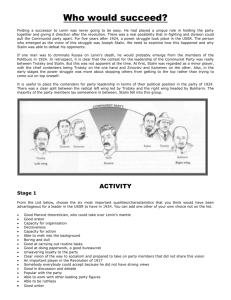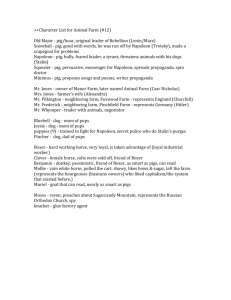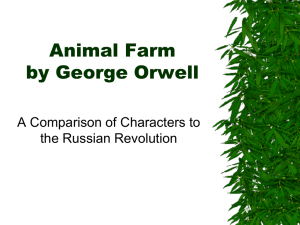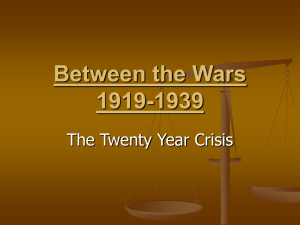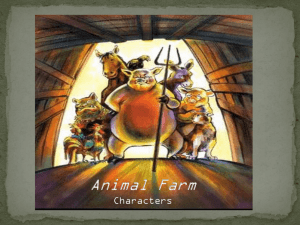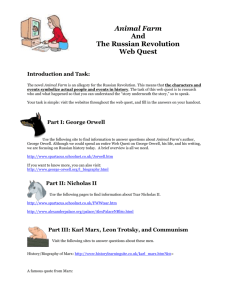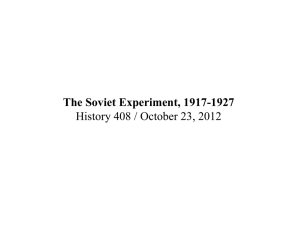Animal Farm - fortbendisd.com
advertisement
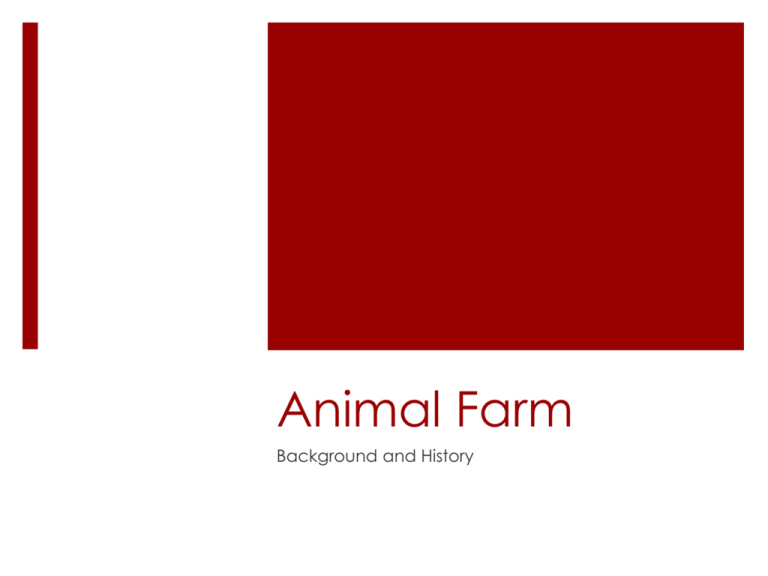
Animal Farm Background and History Russian Society Russia was in an appalling state of poverty while the Czar lived in luxury. There was tremendous dissatisfaction. Czar Nicholas II A poor leader at best, compared to western leaders Cruel - sometimes brutal with opponents Sometimes kind - hired students as spies to make $ Believed he was the unquestionable leader of Russia appointed by God. Had unarmed protesters murdered in the streets in 1905. Karl Marx: The Father of Communism Marx believed that the private ownership of land must be abolished. Believed in “Communal” way of life where everyone shares in prosperity. Invented Communism “Workers of the world unite", take over gov't Dies before Russian Revolution Communism: All people are equal. The Government owns everything, the people own the government. Lenin Lenin adopted Marx’s ideas. He believed that the bourgeoisie (middle class) exploited the workers and must therefore be overthrown. Lenin understood the emotional impact of simple, powerful slogans like workers of the world unite. Changed Russia’s name to the USSR. It is believed Lenin ordered Nicholas II murdered. When Lenin died, there was a power struggle between Trotsky and Stalin. Leon Trotsky One of the leaders of "October Revolution“ along with Lenin and Stalin Believed in “pure” communism, followed Marx Trotsky was a brilliant speaker. With Lenin he succeeded in overthrowing the government in October 1917. Lenin was the President, Trotsky the Commissar for Foreign Affairs. Trotsky Wanted to improve life for all in Russia Chased away by Lenin's KGB (Lenin's secret police) Trotsky favored world revolution. Commissar Former name of a head of a government department in the Soviet Union. Like Secretary of State Colin Powell Civil War From 1918 –1921 there was civil war. Foreign countries including Britain, France, Poland and USA were alarmed at the spread of communism but the Red Army (the Bolsheviks) led by Trotsky proved successful. Joseph Stalin Average speaker, not educated like Trotsky Did not exactly follow Marx's ideas Continually opposed Trotsky Craved power, willing to kill for power Used KGB, allowed church, and propagandized Benefited from the fact that education was controlled Propaganda Department of Stalin’s government Worked for Stalin to support his image Lied to convince the people to follow Stalin Stalin takes Control In his sinister way, Stalin secured his power base, and engineered the permanent exile of Trotsky in 1929. The exiled Trotsky was still very useful to Stalin as he now had Trotsky to blame for all the problems and difficulties that Russia suffered. Politburo : This was the policy-making body of the Communist party’s Central Committee. In reality it was merely a force to carry out Stalin’s orders and secure his position as dictator. Cheka/OGPU/NKVD/KGB These were the various names/initials given to the secret police during Stalin’s dictatorship. KGB - Secret Police Not really police, but forced all to support Stalin Used force, often killed entire families for disobedience Totally loyal, part of Lenin's power, even over army Religion Marx said religion was the "Opiate of the people" and a lie. Religion was tolerated because people would work and not complain. Stalin knew religion would stop violent revolutions. Dedicated, but tricked communist supporters People believed Stalin because he was "Communist" Many stayed loyal after it was obvious Stalin a tyrant Betrayed by Stalin who ignored and killed them Overall details of Russian Revolution Supposed to fix problems from Czar Life was even worse long after revolution Stalin made Czar look like a nice guy Kulaks These were the land-owning peasants who did not want their farms to be collectivized after the revolution. From 1929, Stalin began to exterminate them as a class. 5 Year Plans From 1927-1932, new economic plans, called the five-year plans, were introduced. The purpose was to improve industry Germany and Great Britain Stalin negotiated with both Germany and Great Britain. The Russo-German pact of August 1939 allowed Russia to occupy eastern Poland while Germany occupied the rest. On 22 June, 1941, Germany attacked her ally Russia without warning. Thus the unholy alliance between Nazism and Communism fell apart and Russia formed an alliance with Britain and the USA. Cold War begins The Tehran conference in 1943 presented the Soviet Union, Britain and America as allies. However, by the end of the Second World War, the Soviet Union became an enemy of its allies as the Cold War intensified. Animal Farm & Historical Parallels Old Major: Representative of Marxism. Parallel with Vladimir Lenin, leader of the November 1912 Revolution. Farmer Jones: Representative of the “old order.” Parallel with Czar Nicolas II. Moses, the Raven: Representative of organized religion (i.e. Sugar Candy Mountain”). Parallel with the Patriarch (leader) of the Russian Orthodox Church. Napoleon: Represents the new revolutionary order. Parallel with Joseph Stalin. Animal Farm & Historical Parallels (cont.) Snowball: Represents defending and spreading the revolution. Parallels Leon Trotsky, leader of the Red Army. Squealer: Spreads all of Napoleon's propaganda, including using demonstrations (sheep). Parallel with Pravda, the official newspaper of the Soviet government. Napoleon’s Dogs: Protect Napoleon, carry out executions, enforces his decrees. Parallel with the Cheka and KGB (Soviet secret police). Animal Farm & Historical Parallels (cont.) Pilkington and Foxwood Farm: Becomes friend and ally of Napoleon and Animal Farm. Parallel with Churchill (prime minister) and England. Fredrick and Pinchfield Farm: Represents competition with Animal Farm. Parallel with Hitler (Fuhrer) and Nazi Germany. Boxer: Represented the workforce. Parallel the Russian proletariat (working class). Mollie, the cart horse: Represents the luxury of the “old order”. Parallels the Russian bourgeoisie (middle class). Animal Farm & Historical Parallels (cont.) Mr. Whymper, the broker: Represents “outsiders” who support the rebellion at Animal farm. Parallels foreign agents of the Comintern, an acronym for the Communist Internationale, created to spread the revolution. Pigeons: Were sent to other farms to spread the rebellion from Animal Farm. Parallel with the Communist Internationale, also called the Comintern. 4 Young Pigs: Redirect Napoleon's ideas and are executed. Parallel with the White Russian Army. Events of Animal Farm and their Historical Parallels Battle of Cowshed Attempt by the humans to reclaim Animal Farm and crush the animals’ rebellion. Parallels the British invasion of Russia at Arcangel aimed at removing Lenin and the revolutionary government. Chasing Away Farmer Jones Riding the farm of all human control. Represents the end of the “old order”. Parallels the removal and execution of Nicholas and his family. Events of Animal Farm and their Historical Parallels Napoleon takes over the farm Napolean succeeds Old Major, the pig who had inspired the animals to revolt. Parallels Stalin becoming Soviet dictator in 1926. Building the windmill Creating economic self-sufficiency for the farm. Parallels with Stalin’s 5-Year Plan (NEP) Events of Animal Farm and their Historical Parallels Selling the wood Wood from Animal Farm was sold to Frederick who paid in counterfeit money. Parallels Nazi-Soviet pact. Battle of Windmill Attack led by the humans to destroy the windmill built by the animals. Parallel with the Battle of Stalingrad (German invasion of Russia during WWII). Events of Animal Farm and their Historical Parallels Old Major’s Skull Was dug up and placed in a prominent place in the farmyard. Parallels Lenin’s embalmed body placed on display in Red Square (Lenin’s Tomb). Hoof and horn on the flag Animal Farm flies a green flag with a hoof and horn. Parallels the Soviet flag with the hammer and sickle. Events of Animal Farm and their Historical Parallels Confessions/Executions Confessions of animals (chickens, pigs) to crimes against Animal Farm. Executions of those animals carried out by Napoleon’s dogs. Parallels Stalin’s purges of 1936-38. Final Scene of Animal Farm Meeting of pigs and men. Animals watching can’t tell the difference between them. Parallels the Tehran Conference of 1942 between Franklin Roosevelt, Winston Churchill, and Joseph Stalin. This conference made concessions to the Soviet Union, as well as supporting the independence of Iran. The Author: George Orwell His Early life Originally Eric Arthur Blair Wanted a “manly, English, country sounding ring” Lived in India as a child- lonely- made up stories Did not go to university Worked for the Indian Imperial Police Writing Career Returned to England after illness Started writing newspaper columns, novels, essays, and radio broadcasts Politics His views were affected by fighting the Spanish civil war. Viewed socialists, communists and fascists as self serving and repressive Supported England in WWII Animal Farm Orwell spoke his mind. Criticised the soviet union At first no-one would publish his novel. How it came about Once, he saw a boy whipping a horse. “It struck me that if only such animals became aware of their strength we should have no power over them, and that men exploit animals in the same way as the rich exploit the worker”. (From Orwell’s Preface to Ukrainian translation of ‘Animal Farm’)
